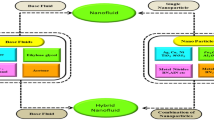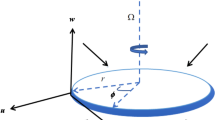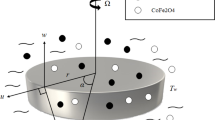Abstract
This work investigates the Sutterby nanofluid due to heated convective boundary features defined across a revolving stretching disk and an applied Darcy-Forchheimer flow. Nanofluids are a mixture of transparent liquids and tiny particles evenly dispersed throughout the base fluid. They have intriguing prospective applications as thermal transfer sources. One of the main purposes of nanofluids is to improve the heat transfer coefficients of base fluids by a considerable amount by the suspension of nanoparticles in the fluids. The Sutterby model, a non-Newtonian fluid, will serve as the foundation for this investigation. Darcy-Forchheimer flow characteristics, heated convective conditions, heat source/sink, chemical reaction, and bioconvection are also taken into account. Appropriate similarity transformations are used to tackle the governing nonlinear differential system. Transformed ordinary differential equations are solved via the Keller box method in the computer program MATLAB. The results of important physical parameters are obtained. Inspirations of important physical parameters are elaborated and briefly studied numerically and visually against the different profiles. The axial, radial, and tangential velocities reduce when the Forchheimer parameter and material parameter increase. Temperature increase in the fluid is a direct consequence of changes in thermal radiation parameters, thermophoresis, and Biot number.













Similar content being viewed by others
Data Availability
No datasets were generated or analyzed during the current study.
Abbreviations
- \(\Gamma\) :
-
Porosity parameter
- \(Da\) :
-
Darcy-Forchheimer
- \(\alpha\) :
-
Fluid parameter
- \(Bi\) :
-
Biot number
- \(Nb\) :
-
Brownian motion
- \(Nt\) :
-
Thermohoresis parameter
- \(Pr\) :
-
Prandtl Number
- \(Rd\) :
-
Radiation parameter
- \(k\) :
-
Mean absorption coefficient
- \(Sc\) :
-
Schmidt number
- \(F'\) :
-
Dimensionless radial velocity
- \(F\) :
-
Dimensionless axial velocity
- \(G\) :
-
Dimensionless tangential velocity
- \(\vartheta\) :
-
Dimensionless temperature field
- \(\Phi\) :
-
Dimensionless concentration field
- \(\Upsilon\) :
-
Dimensionless microorganism field
- \(\tau\) :
-
The ratio of effective heat capacity
- \(\kappa\) :
-
Chemical reaction
- \(Pe\) :
-
Peclet number
- \(Lb\) :
-
Bioconvection Lewis number
- \(\epsilon\) :
-
Microorganism concentration difference
- \(C_fr,C_gr\) :
-
Skin friction coefficient
- \(Nu_{{}_r}\) :
-
Nusselt number
- \(Sh_r\) :
-
Sherwood number
- \(Nh_r\) :
-
Motile density
- \(r,\phi,z\) :
-
Cylindrical coordinates
- \(u,v,w\) :
-
Component of velocity
- \(\omega\) :
-
Angular velocity
- \(c_p\) :
-
Specific heat
- \(\nu\) :
-
Kinematic viscosity
- \(\alpha^\ast\) :
-
Thermal diffusivity
- \(k_1\) :
-
Thermal conductivity
- \(\rho\) :
-
Density of Nanofluid
- \(D_B\) :
-
Brownian diffusion coefficient
- \(D_T\) :
-
Thermophoretic diffusion coefficient
- \(D_M\) :
-
Microorganism diffusion coefficient
- \(\sigma^\ast\) :
-
Stefan-Boltzmann constant
- \(T\) :
-
The temperature of the fluid
- \(T_w\) :
-
Wall temperature
- \(T_\infty\) :
-
Ambient temperature
References
Choi, S. U. S., & Eastman, J. A. (1995). Enhancing thermal conductivity of fluids with nanoparticles in developments and applications of non-Newtonian flows. ASME.
Khan, S. U., Shehzad, S. A., & Ali, N. (2018). Interaction of magneto-nanoparticles in Williamson fluid flow over convective oscillatory moving surface. Journal of the Brazilian Society of Mechanical Sciences and Engineering, 40, 1–12.
Bhatti, M. M., Sarris, I., Michaelides, E. E., & Ellahi, R. (2024). Sisko fluid flow through a non-darcian micro-channel: An analysis of quadratic convection and electro-magneto-hydrodynamics. Thermal Science and Engineering Progress, 50, 102531. https://doi.org/10.1016/j.tsep.2024.102531.
Srinivas Reddy, C., & Ali, F. (2022). Cattaneo–Christov double diffusion theory for MHD Cross nanofluid flow towards a vertical stretching sheet with activation energy. International Journal of Ambient Energy, 43(1), 3924–3933.
Ahmed, M. F., Zaib, A., Ali, F., Bafakeeh, O. T., Tag-ElDin, E. S. M., Guedri, K., & Khan, M. I. (2022). Numerical computation for gyrotactic microorganisms in MHD radiative eyring–Powell nanomaterial flow by a static/moving wedge with Darcy–forchheimer relation. Micromachines, 13(10), 1768.
Ramzan, M., Ali, F., Akkurt, N., Saeed, A., Kumam, P., & Galal, A. M. (2023). Computational assesment of Carreau ternary hybrid nanofluid influenced by MHD flow for entropy generation. Journal of Magnetism and Magnetic Materials, 567, 170353.
Goyal, M., & Bhargava, R. (2014). Boundary layer flow and heat transfer of viscoelastic nanofluids past a stretching sheet with partial slip conditions. Applied Nanoscience, 4(6), 761–767. https://doi.org/10.1007/s13204-013-0254-5.
Uddin, M. J., Bég, O. A., & Ismail, A. I. (2015). Radiative convective nanofluid flow past a stretching/shrinking sheet with slip effects. Journal of Thermophysics and heat Transfer, 29(3), 513–523.
Acharya, N., Bag, R., & Kundu, P. K. (2019). Influence of Hall current on radiative nanofluid flow over a spinning disk: A hybrid approach. Physica E: Low-dimensional Systems and Nanostructures, 111, 103–112.
Mehmood, A., Usman, M., & Weigand, B. (2019). Heat and mass transfer phenomena due to a rotating non-isothermal wavy disk. International Journal of Heat and Mass Transfer, 129, 96–102.
Li, S., Faizan, M., Ali, F., Ramasekhar, G., Muhammad, T., Khalifa, H. A. E. W., & Ahmad, Z. (2024). Modelling and analysis of heat transfer in MHD stagnation point flow of Maxwell nanofluid over a porous rotating disk. Alexandria Engineering Journal, 91, 237–248. https://doi.org/10.1016/j.aej.2024.02.002.
Sutterby, J. L. (1966). Laminar converging flow of dilute polymer solutions in conical sections: Part I. Viscosity data, new viscosity model, tube flow solution. AIChE Journal, 12(1), 63–68.
Khan, M. I., Waqas, H., Farooq, U., Khan, S. U., Chu, Y. M., & Kadry, S. (2021). Assessment of bioconvection in magnetized Sutterby nanofluid configured by a rotating disk: A numerical approach. Modern Physics Letters B, 35(12), 2150202.
Song, Y. Q., Waqas, H., Al-Khaled, K., Farooq, U., Khan, S. U., Khan, M. I., & Qayyum, S. (2021). Bioconvection analysis for Sutterby nanofluid over an axially stretched cylinder with melting heat transfer and variable thermal features: A Marangoni and solutal model. Alexandria Engineering Journal, 60(5), 4663–4675.
Hayat, T., Ahmad, S., Khan, M. I., & Alsaedi, A. (2018). Modeling chemically reactive flow of Sutterby nanofluid by a rotating disk in presence of heat generation/absorption. Communications in Theoretical Physics, 69(5), 569.
Li, S., Khan, M. I., Ali, F., Abdullaev, S. S., Saadaoui, S., & Habibullah (2023). Mathematical modeling of mixed convective MHD Falkner-Skan squeezed Sutterby multiphase flow with non-fourier heat flux theory and porosity. Applied Mathematics and Mechanics, 44(11), 2005–2018. https://doi.org/10.1007/s10483-023-3044-5.
Sajid, T., Tanveer, S., Sabir, Z., & Guirao, J. L. G. (2020). Impact of activation energy and temperature-dependent heat source/sink on Maxwell–Sutterby fluid. Mathematical Problems in Engineering, 2020, 1–15.
Imran, N., Javed, M., Sohail, M., Thounthong, P., & Abdelmalek, Z. (2020). Theoretical exploration of thermal transportation with chemical reactions for sutterby fluid model obeying peristaltic mechanism. Journal of Materials Research and Technology, 9(4), 7449–7459.
Faizan, M., Ali, F., Loganathan, K., Zaib, A., Reddy, C. A., & Abdelsalam, S. I. (2022). Entropy analysis of Sutterby nanofluid flow over a Riga sheet with gyrotactic microorganisms and Cattaneo–Christov double diffusion. Mathematics, 10(17), 3157.
Micromachines, 13(9), 1497.
Ali, F., Loganathan, K., Prabu, E., Eswaramoorthi, S., Faizan, M., Zaib, A., & Chaudhary, D. K. (2022). Entropy minimization on Sutterby nanofluid past a stretching surface with swimming of gyrotactic microorganisms and nanoparticles. Mathematical Problems in Engineering, 2022.
Kuznetsov, A. V. (2011). Bio-thermal convection induced by two different species of microorganisms. International Communications in Heat and Mass Transfer, 38(5), 548–553.
Khan, M., Salahuddin, T., Malik, M. Y., & Khan, F. (2019). Arrhenius activation in MHD radiative Maxwell nanoliquid flow along with transformed internal energy. The European Physical Journal Plus, 134(5), 198.
Ansari, M. S., Otegbeye, O., Trivedi, M., & Goqo, S. P. (2020). Magnetohydrodynamic bio-convective Casson nanofluid flow: A numerical simulation by paired quasilinearisation. Journal of Applied and Computational Mechanics
Waqas, H., Khan, S. U., Bhatti, M. M., & Imran, M. (2020). Significance of bioconvection in chemical reactive flow of magnetized Carreau–Yasuda nanofluid with thermal radiation and second-order slip. Journal of Thermal Analysis and Calorimetry, 140(3), 1293–1306.
Abdelmalek, Z., Ullah Khan, S., Waqas, H., Nabwey, A., H., & Tlili, I. (2020). Utilization of second order slip, activation energy and viscous dissipation consequences in thermally developed flow of third grade nanofluid with gyrotactic microorganisms. Symmetry, 12(2), 309.
Shahid, A., Huang, H., Bhatti, M. M., Zhang, L., & Ellahi, R. (2020). Numerical Investigation on the swimming of gyrotactic microorganisms in nanofluids through porous medium over a stretched surface. Mathematics, 8(3), 380. https://doi.org/10.3390/math8030380
Mansour, M. A., Rashad, A. M., Mallikarjuna, B., Hussein, A. K., Aichouni, M., & Kolsi, L. (2019). MHD mixed bioconvection in a square porous cavity filled by gyrotactic microorganisms. International Journal of Heat and Technology, 37(2), 433–445.
Usman, M., Hamid, M., & Rashidi, M. M. (2019). Gegenbauer wavelets collocation-based scheme to explore the solution of free bio-convection of nanofluid in 3D nearby stagnation point. Neural Computing and Applications, 31, 8003–8019.
Khan, M. N., & Nadeem, S. (2020). Theoretical treatment of bio-convective Maxwell nanofluid over an exponentially stretching sheet. Canadian Journal of Physics, 98(8), 732–741.
Uddin, M. J., Kabir, M. N., Alginahi, Y., & Bég, O. A. (2019). Numerical solution of bio-nano-convection transport from a horizontal plate with blowing and multiple slip effects. Proceedings of the Institution of Mechanical Engineers, Part C: Journal of Mechanical Engineering Science, 233(19–20), 6910–6927.
Mosayebidorcheh, S., Tahavori, M. A., Mosayebidorcheh, T., & Ganji, D. D. (2017). Analysis of nano-bioconvection flow containing both nanoparticles and gyrotactic microorganisms in a horizontal channel using modified least square method (MLSM). Journal of Molecular Liquids, 227, 356–365.
Nadeem, S., Khan, M. N., Muhammad, N., & Ahmad, S. (2019). Mathematical analysis of bio-convective micropolar nanofluid. Journal of Computational Design and Engineering, 6(3), 233–242.
Anwar Bég, O. (2018). Nonlinear multiphysical laminar nanofluid bioconvection flows: Models and computation. Computational Approaches in Biomedical Nano-Engineering, 113–145.
Shahid, A., Huang, H. L., Bhatti, M. M., & Marin, M. (2022). Numerical computation of magnetized bioconvection nanofluid flow with temperature-dependent viscosity and Arrhenius kinetic. Mathematics and Computers in Simulation, 200, 377–392. https://doi.org/10.1016/j.matcom.2022.04.032.
Yasmin, H., Lone, S. A., Ali, F., Alrabaiah, H., Raizah, Z., & Saeed, A. (2023). Thermal radiative flow of cross nanofluid due to a stretched cylinder containing microorganisms. Nanotechnology Reviews, 12(1). https://doi.org/10.1515/ntrev-2023-0147.
Forchheimer, P. H. (1901). Wasserbewegung. Ver Dtsch Ing, 45, 1782–1788.
Muskat, M. (1938). The flow of homogeneous fluids through porous media. Soil Science, 46(2), 169.
Sadiq, M. A., & Hayat, T. (2016). Darcy–Forchheimer flow of magneto Maxwell liquid bounded by convectively heated sheet. Results in Physics, 6, 884–890.
Ali, F., Arif, M., Faizan, M., Saeed, A., Seangwattana, T., Kumam, P., & Galal, A. M. (2023). Darcy Forchheimer flow of CMC-water based hybrid nanofluid due to a rotating stretchable disk. Heliyon, 9(7), e17641. https://doi.org/10.1016/j.heliyon.2023.e17641.
Hayat, T., Aziz, A., Muhammad, T., & Alsaedi, A. (2018). An optimal analysis for Darcy–forchheimer 3D flow of nanofluid with convective condition and homogeneous–heterogeneous reactions. Physics Letters A, 382(39), 2846–2855.
Ali, F., Zaib, A., Yasmin, H., Lone, S. A., Shahab, S., & Saeed, A. (2024). Scrutinization using both numerical and analytical techniques for Darcy Forchheimer flow in the gyrotactic microorganism of nanofluid over a rotating disk. Numerical Heat Transfer Part B: Fundamentals, 1–23. https://doi.org/10.1080/10407790.2023.2300678.
Shah, Z., Dawar, A., Islam, S., Khan, I., & Ching, D. L. C. (2018). Darcy-Forchheimer flow of radiative carbon nanotubes with microstructure and inertial characteristics in the rotating frame. Case Studies in Thermal Engineering, 12, 823–832.
Sajjadi, H., Delouei, A. A., Izadi, M., & Mohebbi, R. (2019). Investigation of MHD natural convection in a porous media by double MRT lattice Boltzmann method utilizing MWCNT–Fe3O4/water hybrid nanofluid. International Journal of Heat and Mass Transfer, 132, 1087–1104.
Vafai, K. (1984). Convective flow and heat transfer in variable-porosity media. Journal of Fluid Mechanics, 147, 233–259.
Chandrasekhara, B. C., & Namboodiri, P. M. S. (1985). Influence of variable permeability on combined free and forced convection about inclined surfaces in porous media. International Journal of Heat and Mass Transfer, 28(1), 199–206.
Ibrahim, F. S., & Hassanien, I. A. (2000). Influence of variable permeability on combined convection along a nonisothermal wedge in a saturated porous medium. Transport in Porous Media, 39, 57–71.
Rees, D. A. S., & Pop, I. (2000). Vertical free convection in a porous medium with variable permeability effects. International Journal of heat and mass Transfer, 43(14), 2565–2571.
Hamdan, M. H., & Kamel, M. T. (2011). Flow through variable permeability porous layers. Adv Theor Appl Mech, 4(3), 135–145.
Ali, F., Padmavathi, T., & Hemalatha, B. (2022). Entropy minimization in Darcy Forchheimer on Sutterby nanofluid past a stretching surface with swimming of gyrotactic microorganisms. Waves in Random and Complex Media, 1–24. https://doi.org/10.1080/17455030.2022.2112635.
Keller, H. B. (1971). A NEW DIFFERENCE SCHEME FOR PARABOLIC PROBLEMS**This work was supported by the U. S. Army Research Office, Durham, under Contract DAHC 04-68-C-0006. In Numerical Solution of Partial Differential Equations–II (pp. 327–350). Elsevier. https://doi.org/10.1016/B978-0-12-358502-8.50014-1.
Funding
This study is supported via funding from Prince sattam bin Abdulaziz University project number (PSAU/2024/R/1445).
Author information
Authors and Affiliations
Contributions
Conceptualization, A.S. and H.Y.; methodology, S.S.Z.; software, A.S.; A.A.B.; validation, A.Z., S.S.Z., and F.S.A.; formal analysis, A.A.B.; investigation, S.S.Z. and A.S.; writing—original draft preparation, A.Z. and F.S.A.; writing—review and editing, H.Y. and F.S.A.; visualization, H.Y. and A.A.B.
Corresponding authors
Ethics declarations
Conflict of Interest
The authors have no conflict of interest.
Research Involving Humans and Animals Statement
None.
Informed Consent
None.
Ethical Approval
Not applicable.
Additional information
Publisher’s Note
Springer Nature remains neutral with regard to jurisdictional claims in published maps and institutional affiliations.
Rights and permissions
Springer Nature or its licensor (e.g. a society or other partner) holds exclusive rights to this article under a publishing agreement with the author(s) or other rightsholder(s); author self-archiving of the accepted manuscript version of this article is solely governed by the terms of such publishing agreement and applicable law.
About this article
Cite this article
Zafar, S.S., Zaib, A., Alduais, F.S. et al. A Keller Box Technique of the Sutterby Nanomaterial Including Gyrotactic Microorganisms Over a Rotating Disk. BioNanoSci. (2024). https://doi.org/10.1007/s12668-024-01404-1
Accepted:
Published:
DOI: https://doi.org/10.1007/s12668-024-01404-1




